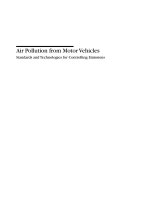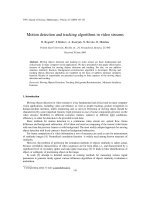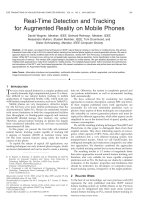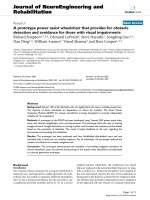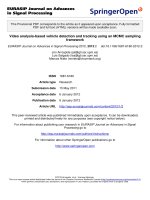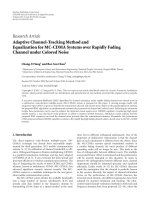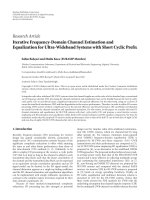Multiple vehicles detection and tracking for intelligent transport systems using machine learning approaches
Bạn đang xem bản rút gọn của tài liệu. Xem và tải ngay bản đầy đủ của tài liệu tại đây (556.57 KB, 11 trang )
Transport and Communications Science Journal, Vol. 70, Issue 3 (09/2019), 214-224
Transport and Communications Science Journal
MULTIPLE VEHICLES DETECTION AND TRACKING FOR
INTELLIGENT TRANSPORT SYSTEMS USING MACHINE
LEARNING APPROACHES
Ngoc Dung Bui1, Dzung Lai Manh1, Vu Hieu Tran1, Binh T. H. Nguyen2
1
University of Transport and Communications, No 3 Cau Giay Street, Hanoi, Vietnam.
2
Ho Chi Minh City University of Technology, HCM City, Vietnam.
ARTICLE INFO
TYPE: Research Article
Received: 29/6/2019
Revised: 31/8/2019
Accepted: 16/9/2019
Published online: 15/11/2019
/>*
Corresponding author
Email: ; Tel: 0964978112
Abstract. Video surveillance is emerging research field of intelligent transport systems. This
paper presents some techniques which use machine learning and computer vision in vehicles
detection and tracking. Firstly the machine learning approaches using Haar-like features and
Ada-Boost algorithm for vehicle detection are presented. Secondly approaches to detect
vehicles using the background subtraction method based on Gaussian Mixture Model and to
track vehicles using optical flow and multiple Kalman filters were given. The method takes
advantages of distinguish and tracking multiple vehicles individually. The experimental
results demonstrate high accurately of the method.
Keywords: Vehicle detection, tracking, background subtraction, optical flow, Kalman filters.
© 2019 University of Transport and Communications
1. INTRODUCTION
Video surveillance system has become widely deployed in many aspects of life,
especially in Intelligent Transportation systems (ITS). Using cameras and the image
processing algorithms, the traffic flow can be measured under various environment conditions
by detecting vehicles methods [1, 2]. In video surveillance system, there are three
fundamental steps of image processing which are image acquiring, pre-processing and
analyzing. Result of analyzing step are contents which then can be used for object
214
Transport and Communications Science Journal, Vol. 70, Issue 3 (09/2019), 214-224
recognition. In an ITS with static cameras, motion is used as major factors for object
recognition process. A robust moving object detection algorithm must handle the nonidealities of scenes such as changes in illumination, high frequency motion, changes of longterm scene, and also shadows. For the past decade, numerous algorithms were proposed to
deal with the above mentioned problems [3, 4, 5]. Computer vision plays a very important
role in the development of video surveillance technology. Successful applications of computer
vision could be found in many fields such as video surveillance, face recognition, finger and
iris recognition, and especially in transportation [6, 7, 8]. Applying computer vision
techniques, the features of face, finger and iris can be extract from the image, person can be
automatically identified or verified by recognition systems [9]. In video surveillance, series of
computer vision algorithms will be applied on the sequence of images from camera to extract
the objects or human and analyze their behaviour, characterize and decide their behaviour is
normal or abnormal [10]. In transportation, computer vision can be apply to automatically
monitor traffic by extract each kind of vehicle and transmit numerical data to the transport
management centres [11].
Recently, a lot of camera surveillance systems was deployed [12]. There are two kinds of
systems which are semi-automatic and automatic system. With the first one, the camera only
capture and store images from the roads, technical staffs will then analyze contents from the
image. With the second one, all the surveillances are automatically processed without any
interaction from people. This automatic surveillance system can automatically detect moving
vehicles, track the vehicles in their lanes and calculate the speed of the vehicles [13]. Many
advanced pattern recognition technique are also applied together in the automatic system to
detect, track the moving vehicles and measure traffic flow at day and night time by recognize
headlight and taillight of vehicles [14].
2. MACHINE LEARNING APPLICATIONS FOR ITS
2.1. Vehicles detection based on machine learning approaches
In any traffic management and planning system, the first and most important step is
collecting basic characteristics of traffic flows such as flow rate, speed and density. These
characteristics are source for deployment of many intelligent transport systems’ applications
such as traffic signal controlling, transportation organization and management. During recent
years, researches in traffic management and planning system field and to be more specific in
vehicles detection and tracking field has become more urgent. Some successful research
approaches of will be reviewed in the next part of this paper.
In order to obtain basic flow characteristics from traffic surveillance cameras, a process
of analyzing images received from the camera must be created. Normally the process has two
main stages: (1) extracting features from the images and (2) detecting and classifying vehicles
based on the features. This process is illustrated in the figure 1 with four levels of complexity.
215
Transport and Communications Science Journal, Vol. 70, Issue 3 (09/2019), 214-224
At every levels, the final steps always contains classifiers which will detect and classify
vehicles.
Figure 1. Complexity levels of feature extracting in traditional recognition [6].
(1) Extracting features from the images
Features on the images can be simply a collection of special pixels which have different
color or intensity from the neighbor’s pixels. Features are normally pixels on the angle or
edge of images’ objects. Some implementation of extracting features have been proposed such
as LBP (Local Binary Pattern), HoG (Histogram of Oriented Gradient)… The characteristics
of objects can have complex structures, for example an image area where pixels are
interlinked follow certain principles. The example of classical principles are distribution of
special pixels or the same rule in changing of intensity or light direction. Some machine
learning approaches such as SVM (Support Vector Machine), AdaBoost based on Haar-like
features have been proposed for these purposes.
(2) Vehicle detection and classification
The next step, the extracted features will be compared with a sample features set, then
vehicles will be detected and classified. The set of sample features is built using pattern
recognition methods and supervised learning techniques. The most popular supervised
learning approaches are neural networks with feed or back propagations using Haar-like
features combine with Ada-Boost algorithms.
A fast, popular and effective object-detection method Viola and Jones’s method which
use Haar-like features [15]. The proposed Haar-like characteristics are rectangles with dark
light areas interleaved as shown in figure 2.
Figure 2. Basic Haar-like features.
216
Transport and Communications Science Journal, Vol. 70, Issue 3 (09/2019), 214-224
Basic Haar-like features can be extended to recognize objects in more effectively ways.
There are three groups of Basic Haar-like features: edge, line, center-surround. Extended
Haar-like features are showed in figure 3.
The edge features
The line features
And the center-surround features:
Figure 3. Extended Haar-like features.
Haar-like features’ intensity values of pixels are different between pixels in bright areas
and dark areas. These values can be quickly calculated based on integral image. Then these
values apply AdaBoost algorithm to train strong classifier to identify objects on the image
according to the [16]. To obtain a strong classifier, each calculated Haar-like characteristic is
used to establish a weak classifier according to the formula number 2.
+1 if Vi Ti
hi =
−1 if Vi Ti
(1)
where, Vi is the Haar-like feature value, Ti is the threshold for establishing a weak
classifier, the threshold value is the Haar-like feature value of an sample image in the training
set. Value hi = +1 if the input image is a vehicle that needs to be detected, in other words, this
classifier detected correctly input image. Conversely, hi = -1 means that the input image is not
a vehicle.
There is one problem, what is the suitable value of threshold Ti. In other words, which
sample in the training data set should be chosen to calculate Haar-like features to set threshold
for classifier? In addition, with an input image, size is often much larger than the sample
image size, we must consider to utilize a lot sub-windows for the input image. With these subwindows, only a small number contain vehicles that need to be identified. If you consider all
of sub-windows are equally important then it will waste huge amount of computing resources.
Solving these two mentioned problems, the strong classifier is concluded on the basis of
many weak classifiers which arranged in a multi-layer structure. Each weak classifier
performs classification whether or not a vehicle that needs to be identified in the sub-window
under consideration with accuracy is less than 50%. At each layer, the sub-window is
removed if the classifier determines there is no vehicle. Conversely, the sub-window will be
217
Transport and Communications Science Journal, Vol. 70, Issue 3 (09/2019), 214-224
moved to the next layer. A sub-window contains a vehicle that needs to be identified if it
passes through all layers and is classified by the last layer as containing a vehicle.
sub-window
Classifier
yes
1
no
yes
2
yes
3
no
no
4….. m-1
no ... no
yes
yes
m
is a vehicle
no
not a
vehicle
Removing sub-window
Figure 4. Concluding strong classifier based on multi weak classifiers.
The results of vehicle detection and classification use Haar-like feature according to the
cascade model illustrated in the following figure 5.
Figure 5. Discover and classify vehicles using Haar characteristics.
In experiment of medium traffic density, the accuracy of traffic vehicle detection and
classification method using Haar-like characteristics using AdaBoost algorithms are quite
high. However, in high-density traffic conditions, this model has low accuracy because many
vehicles are partially hidden and as a result the strong classifier cannot detect these vehicles.
It causes limitation of this approach in mixed traffic condition in Vietnam. The mixed traffic
218
Transport and Communications Science Journal, Vol. 70, Issue 3 (09/2019), 214-224
condition is quite common in Vietnamese big cities which have various types of vehicles.
2.2. Vision based approach for vehicle tracking and estimation of traffic flow
parameters
Machine learning approaches for detecting and counting vehicles have advantages such
as can identify each type of vehicles, allow statistics and classification of vehicles. But there
are some disadvantages still exist such as the computational complexity and the low accuracy
in high density flow conditions. Moreover, these approaches still lack the abilities to
distinguish different type of vehicles, the reason is similarities of vehicles and complex of
transportation means. Therefore, this solution is often applied in areas with low traffic
density, where vehicles travel clearly in specific lanes such as on highways. In Vietnamese
big cities, the traffic flow is mixed and has high density. There are also various types of
vehicles that do not strictly follow their lanes. The majority of vehicles are motorcycles. The
solutions of motion detection algorithm is based on background subtraction and optical flow
[17] have been applied to estimate the average velocity of the traffic flow and the occupancy
density of vehicles on the road. Block diagram illustrated estimation process of traffic flow
parameters has been shown in figure 6.
Frame
sequence
Preprocessing
Background
subtraction
Binary
conversion
Morphological
conversion
Estimation of
velocity/density
optical flow
calculation
Vehicle
extracting
Figure 6. Traffic flow parameter estimation process.
Figure 7. Result of background subtraction.
219
Transport and Communications Science Journal, Vol. 70, Issue 3 (09/2019), 214-224
Image pre-processing: The video frames streamed from the camera, then image preprocessing transformations such as image resizing, color to gray image conversion are
performed to reduce the computational complexity.
Background subtraction: The background subtraction algorithm is applied to extract
traffic vehicles (foreground objects) from the image background, which are installed
according to the mixture of Gaussians model. To detect the moving object from the
background, the solution is to calculate the absolute deviation of the intensity of the pixels
between two consecutive frames. Through the difference of intensity between two
consecutive frames at the same position, it determines whether this pixel belongs to the
background or the foreground object.
Binary and morphological transformations: The next step in the process of vehicle
tracking from the background is to convert the resulting image to a binary image and apply
some morphological transformations to integrate the discrete pixels which belong to a
vehicles. These conversions improve the accuracy of vehicle tracking results.
Figure 8. Binary and morphological conversion step.
Vehicle extracting: The edge detection algorithm is applied to localize a moving vehicle,
and separating the foreground object from the background. The rectangular boundaries are
drawn around the moving object separated from the image background.
Figure 9. Extracting traffic vehicles.
220
Transport and Communications Science Journal, Vol. 70, Issue 3 (09/2019), 214-224
Optical flow calculation: The Optical flow algorithm [17] is performed to calculate the
displacement of the image-based pixels according to the frame flow, as shown in Figure 9,
where the detected points are shifted from the previous frame shown. At these pixels, the
displacement vector is drawn and shown on the image. These vectors are used to estimate
vehicle velocity.
Figure 10. Result of optical flow calculation.
2.3. Vehicles tracking using multiple Kalman filters
Beside Optical flow method, Kalman filter can be used to predict each vehicle in current
time. Normally, a Kalman filter is used to estimate the state of a linear system where the state
is assumed to be distributed by a Gaussian. It is typically divided into two steps: prediction
and correction. The purpose of prediction step is to estimate the state based on the state
equation. Similarly the correction step uses the current observations to update the vehicle’s
state. In this paper, to track multiple vehicle simultaneously, multiple Kalman filters as
number of vehicles is used [9]. Each Kalman filter is represented as below:
xk = Axk −1 + wk
(2)
zk = Hxk + vk
T
where x = px p y vx v y , px , py are the center position of x-axis and y-axis,
respectively. vx , v y are the velocity of x-axis and y-axis. Matrix A represents the transition
matrix, matrix H is the measurement matrix, and T is the time interval between two adjacent
fames. wk and vk are the Gaussian noises with the error covariance Qk and Rk . The Kalman
filter is process as follow:
Update the state: xk |k −1 = Axk −1|k −1
Predict the measurement: zk |k −1 = Hxk |k −1
Update the state error covariance: Pk |k −1 = APk −1|k −1 AT + Qk
221
Transport and Communications Science Journal, Vol. 70, Issue 3 (09/2019), 214-224
To track multiple vehicles in complex transportation, matching between vehicles and
measurement should be performed correctly. In this paper, we employ the data association
method, which split and merge the vehicles [9]. The overall tracking method is given in figure 11.
Figure 11. The flow chart of vehicles tracking method.
Figure 12 shows the results for the multiple vehicles tracking. When a car or motorbike
comes to the region of the camera, it will be assigned a new tracking object and initialize
tracking window for this object. The tracking results of multiple vehicles show the tracking
method is able to correctly track the new vehicle in transportation camera surveillance. For
the case of several vehicles run near each other, we need data association method to
distinguish each vehicles.
Figure 12. Vehicles tracking using multiple Kalman filters.
222
Transport and Communications Science Journal, Vol. 70, Issue 3 (09/2019), 214-224
4. CONCLUSION
In this paper, we presented the detection and tracking method for multiple vehicles based
on various methods including background subtraction, optical flow and Kalman filter. All
vehicles are detected using background subtraction. For each vehicle, the optical flow and
Kalman filter was established and bounding boxes was used as features. The Kalman filter
estimates the state based on the state equation and corrects using the current observations to
update the vehicle’s state. Results of this paper show that this method can be applied in
transport management centre for traffic monitoring.
ACKNOWLEDGMENT
This research was supported by a grant from UTC project number T2019-CN-013 TD
and T2019-CN-005.
REFERENCES
[1] M.S., Shirazi, B. Morris, Traffic Flow Classification Using Traffic Cameras. In: Bebis G. et al.
(eds) Advances in Visual Computing. ISVC 2018, Lecture Notes in Computer Science, 11241.
Springer, Cham, 2018.
[2] Bas, Erhan, A. Tekalp, F. Salman, Automatic Vehicle Counting from Video for Traffic Flow
Analysis, Istanbul, Turkey, 392 – 397, 2007. />[3] N. T. H. Binh, T. Q. H. Bang, N. D. Bui, Robust and Adaptive Shadow Detection in Surveillance
Systems using Gausian Processes, RIVF, 29-33, 2016
[4] Yizhong Yang, Qiang Zhang, Pengfei Wang, Xionglou Hu, and Nengju Wu, Moving Object
Detection for Dynamic Background Scenes Based on Spatiotemporal Model, Advances in Multimedia,
2017 (2017) 9 pages. />[5] Jin Min Choi, Hyung JinChang, Yung Jun Yoo, Jin Young Choi, Robust moving object detection
against fast illumination change, Computer Vision and Image Understanding, 116 (2012) 179-193.
/>[6] Bruce E. Flinchbaugh; Thomas J. Olson, Emerging Applications of Computer Vision, 1997
[7] Al-Osaimi; Mohammed Bennamoun; Ajmal Mian, An Expression Deformation Approach to
Non-rigid 3D Face Recognition, International Journal of Computer Vision, 81 (2009) 302–316.
/>[8] H. Moon, R. Chellapa, A. Rosenfeld, Performance analysis of a simple vehicle detection
algorithm, 20 (2003) 1-13. />[9] NeeruRathee, A novel approach for lip Reading based on neural network, 2016 International
Conference on Computational Techniques in Information and Communication Technologies
(ICCTICT), New Delhi, India, 2016.
[10] Song Yale, Louis-Philippe Morency, Randall Davis, Distribution-Sensitive Learning for
223
Transport and Communications Science Journal, Vol. 70, Issue 3 (09/2019), 214-224
Imbalanced Datasets, 10th IEEE International Conference and Workshops on Automatic Face and
Gesture Recognition (FG), Shanghai, China, 2013
[11] Chieh-Chih Wang, Cw Thorpe, Arne Suppe, LADAR-based detection and tracking of moving
objects from a ground vehicle at high speeds, IEEE IV2003 Intelligent Vehicles Symposium.
Proceedings (Cat. No.03TH8683), Columbus, OH, USA, 2003.
[12] Le Hung Lan et al., Application of integrated technologies to monitor and process traffic data to
improve operational capacity and road safety in Vietnam, Ministry of Education and Teaching
Bilateral Project, 2016.
[13] Andrew H. S. Lai, N. H. C. Yung, Lane detection by orientation and length discrimination, IEEE
Trans.
Systems,
Man,
and
Cybernetics,
Part
B,
30 (2000)
539
– 548.
/>[14] Yoichiro Iwasaki, Masato Misumi, Toshiyuki Nakamiya, Robust Vehicle Detection under
Various Environments to Realize Road Traffic Flow Surveillance Using an Infrared Thermal Camera,
The Scientific World Journal, 2015 (2015) 11 pages. />[15] P. Viola, M. Jones, Rapid Object Detection using a Boosted Cascade of Simple Features.
Proceedings of IEEE Conference on Computer Vision and Pattern Recognition(CVPR), Hawaii, USA,
511-518, 2001.
[16] Yoav Freund, Raj Iyer, Robert E. Schapire, Yoram Singer, An Efficient Boosting Algorithm for
Combining Preferences, 4 (2003) 933-969.
[17] David J. Flee, Yair Weiss, Optical Flow Estimation, In Paragios; et al. Handbook of
Mathematical Models in Computer Vision. Springer, 2006.
224

